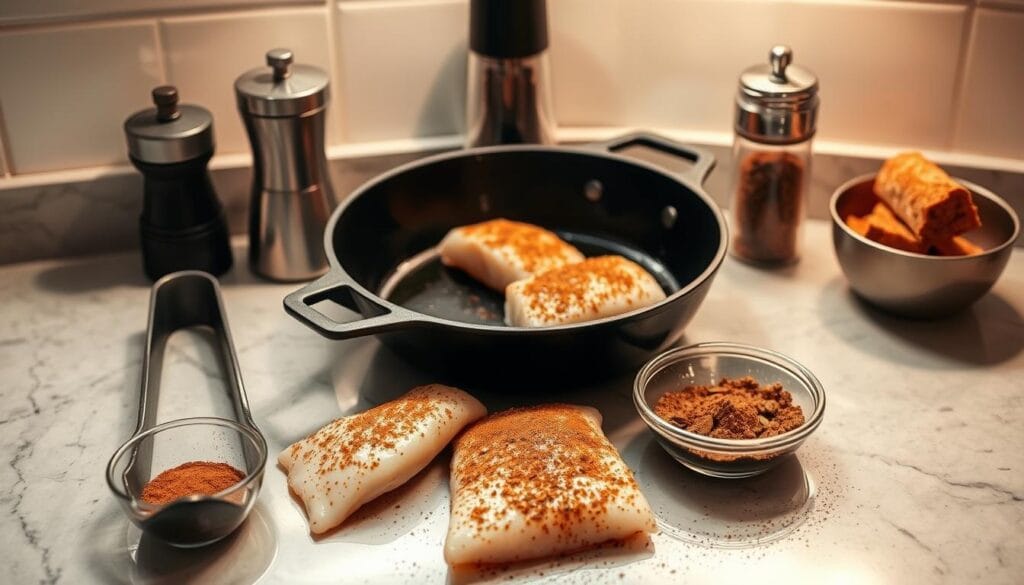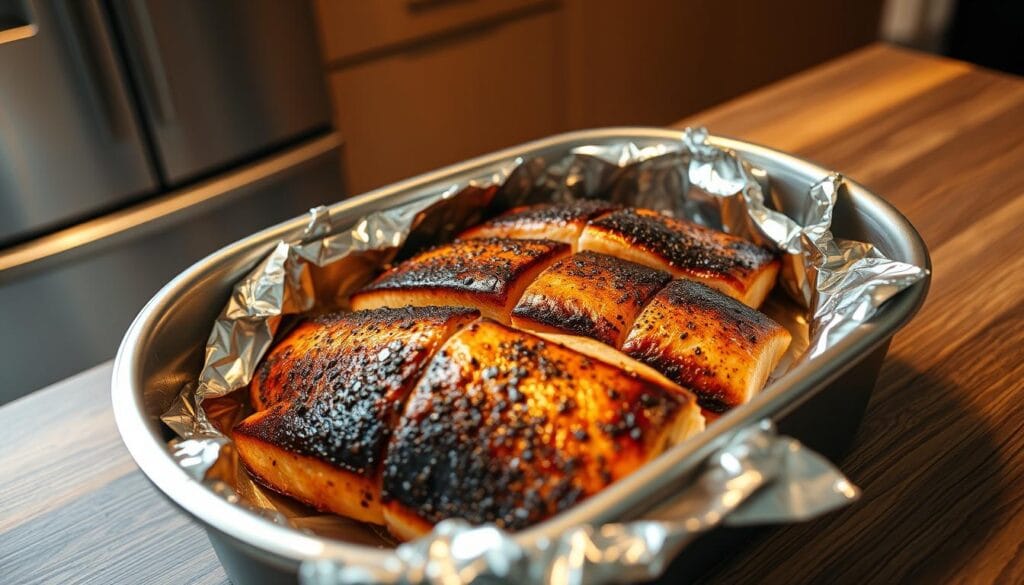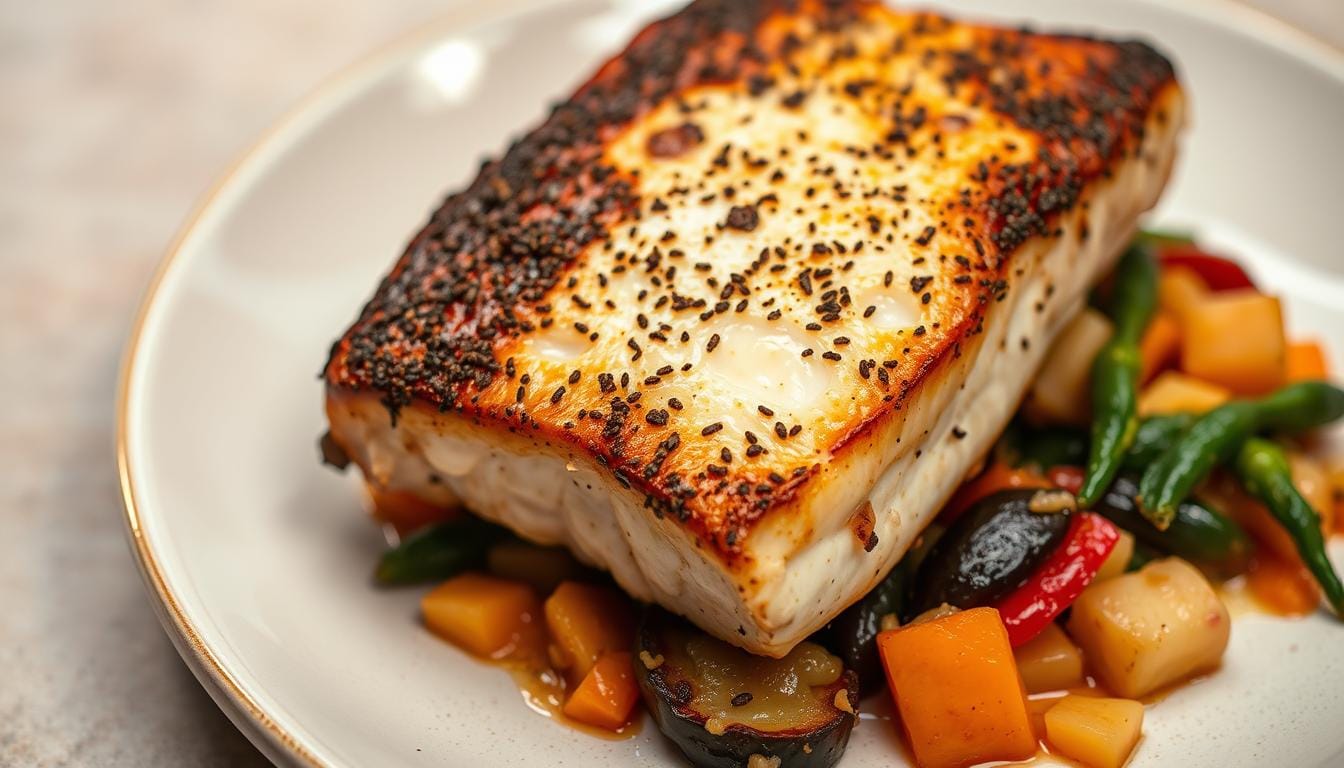The first time I tasted blackened mahi mahi, it was a game-changer. The fish arrived sizzling with a rich crust that hinted at a burst of flavor. Growing up in coastal Florida, seafood was familiar. But this dish showed me how amazing a simple fish could taste.
Table of Contents
Blackened mahi mahi comes from Louisiana’s vibrant Cajun cuisine. It’s more than a meal; it’s a celebration of bold flavors and cooking traditions. The delicate fish is coated in a powerful spice blend, creating a dark crust while staying tender inside.
blackened mahi mahi
This dish is about more than cooking. It’s about diving into a rich culinary tradition that turns simple ingredients into something special. Whether you love seafood or are just curious, blackened mahi mahi is a journey into intense, delicious flavors.
Key Takeaways
- Blackened mahi mahi is a classic Cajun seafood dish
- The recipe features a signature spice blend and unique cooking method
- Mahi mahi offers a delicate, versatile fish perfect for blackening
- The technique creates a flavorful, crispy exterior
- Suitable for both home cooks and seafood lovers
Understanding Mahi Mahi: A Premium White Fish
Mahi mahi is a top pick for seafood lovers. It’s known for its great taste, texture, and health benefits. These qualities make it a hit in many recipes.
What Makes Mahi Mahi Special
Mahi mahi, or dolphinfish, is special in your recipes. It has:
- Firm, white flesh with a mild, sweet taste
- It’s great for blackening, showing its versatility
- Its vibrant golden-green scales add to its appeal
“Mahi mahi is the secret weapon for creating restaurant-quality seafood dishes at home.” – Seafood Culinary Experts
Nutritional Benefits of Mahi Mahi
Health fans love mahi mahi for its nutritional value. It’s packed with good stuff and low in calories:
- It’s a top protein source
- It’s low in saturated fat
- It’s rich in omega-3 fatty acids
- It’s a great source of vitamin B12 and selenium
Selecting Fresh Mahi Mahi
Choosing the right fish is key for your recipe. Look for these signs of freshness:
- Bright, consistent color
- Firm flesh that springs back
- Clean, ocean-like smell
- Minimal browning or discoloration
Pro tip: Buy mahi mahi from trusted seafood markets or fishmongers for the best quality.
Essential Ingredients for Blackened Mahi Mahi
To make perfect blackened mahi mahi, start with top-notch ingredients. Your seasoning blend will turn a simple fish into a dish fit for a restaurant.
Here are the key ingredients for your spice rub:
- Fresh mahi mahi fillets (preferably never frozen)
- Unsalted butter or high-smoke-point oil
- Spices for seasoning blend
For your seasoning, you’ll need:
- Paprika (gives rich color and mild taste)
- Cayenne pepper (adds heat)
- Garlic powder
- Onion powder
- Dried oregano
- Dried thyme
- Salt
- Black pepper
The butter is key in making blackened mahi mahi. Its milk solids brown, creating a tasty crust. This crust is what makes the dish look and taste amazing.
| Ingredient | Purpose | Recommended Type |
|---|---|---|
| Mahi Mahi Fillets | Primary protein | Fresh, skin-on preferred |
| Butter | Creates crust and adds flavor | Unsalted, high-quality |
| Cooking Oil | Prevents sticking | Avocado or canola oil |
Adding fresh lemon wedges and chopped herbs can make your dish even better. They add freshness and color to your blackened mahi mahi.
The Perfect Cajun Blackening Seasoning Blend
Creating the best blackened mahi mahi recipe starts with a killer seasoning blend. The right mix of spices can make your mahi mahi go from ordinary to extraordinary. It brings out the fish’s delicate flavor and adds a robust Cajun kick.
Core Spices for Authentic Flavor
Your blackened mahi mahi seasoning should have a mix of spices that add depth and complexity. The classic blend includes:
- Paprika (provides rich color and mild sweetness)
- Garlic powder (adds intense flavor)
- Onion powder (brings subtle sweetness)
- Dried thyme (introduces earthy notes)
- Dried oregano (contributes herbal undertones)
- Cayenne pepper (delivers signature heat)
- Sea salt (enhances overall taste)
- Black pepper (provides sharp warmth)
Customizing Your Heat Level
The beauty of homemade blackened mahi mahi seasoning is its flexibility. You can adjust the heat by changing the cayenne pepper amount. Start with a small amount and gradually increase to find your perfect spice level.
“The secret to great seasoning is balance – no single spice should overpower the others.” – Culinary Experts
Smart Storage Solutions
To keep your seasoning fresh and potent, store it in an airtight container away from direct sunlight and heat. A cool, dark pantry works perfectly. Properly stored, your homemade blackened mahi mahi seasoning can last up to 3-6 months. This ensures you’re always ready for a delicious seafood meal.
Preparing Your Fish for Blackening
Creating the perfect blackened mahi mahi begins with careful preparation. The success of your dish depends on how well you prepare the fish before cooking. Professional chefs emphasize the importance of proper preparation for that restaurant-quality taste.
Start by picking fresh mahi mahi fillets and drying them completely with paper towels. Moisture hinders a crisp, flavorful crust. Use clean towels or paper towels to remove excess water, helping the fish develop a perfect crust.
- Inspect the mahi mahi for any remaining scales or bones
- Pat the fillets dry with clean paper towels
- Ensure the fish surface is completely moisture-free
Then, mix your blackening seasoning blend. Aim for an even coating over the fish’s surface. Gently press the spice mixture onto the mahi mahi, ensuring each fillet is evenly covered. This step is vital for the fish’s signature flavor and texture.
Pro tip: Let the seasoned fish rest for 5-10 minutes before cooking. This allows the spices to stick better and penetrate the fish, enhancing the flavor. The brief resting period helps the seasoning bond with the fish, preparing it for a perfect blackening.
The key to exceptional blackened mahi mahi is in the preparation: dry fish, even seasoning, and patience.
Mastering the Blackening Technique
Cooking blackened mahi mahi needs precision and skill. This technique turns simple fish into a dish that’s both crispy and flavorful. It’s important to understand the cooking process when making blackened mahi mahi.
Three things are key for successful blackening: temperature, timing, and technique. You aim for a perfectly seared outside and a moist, tender inside.
Temperature Control Secrets
The right heat is crucial for cooking blackened mahi mahi. Here are some temperature tips:
- Use a cast-iron skillet for the best results
- Preheat the pan to extremely hot (around 450-500°F)
- Make sure the pan is evenly heated before adding the fish
Precise Cooking Times
Timing is everything in cooking blackened mahi mahi. Here’s a general guide:
- Cook the fish for 3-4 minutes on the first side
- Cook for 2-3 minutes on the second side
- Total cooking time: about 5-7 minutes
Achieving the Perfect Crust
Getting the perfect blackened crust is all about attention to detail. Pat the fish dry before seasoning, cook at high heat, and don’t move the fish too much. A well-seasoned cast-iron skillet helps achieve that crispy exterior without burning the fish.
Essential Kitchen Equipment for Blackening

Preparing a delicious blackened mahi mahi recipe requires the right tools. The key to success is choosing equipment that can handle high heat and control cooking well.
The cast-iron skillet is your most important tool. It keeps heat evenly, which is vital for that perfect blackened crust. Cast iron’s consistent heat turns a simple fish dish into a gourmet meal.
Must-Have Tools for Blackening
- Cast-iron skillet: The gold standard for blackening
- Fish spatula: Ensures delicate fish stays intact during cooking
- Instant-read thermometer: Helps monitor precise cooking temperatures
- Powerful kitchen ventilation system: Manages smoke and odors
If you don’t have a cast-iron skillet, stainless steel or carbon steel pans work too. They might not season as well, but with the right technique, they can still make great food.
Pro Tips for Equipment Selection
- Invest in a high-quality skillet with excellent heat retention
- Choose a flexible fish spatula for precise food handling
- Ensure your kitchen has adequate ventilation
- Consider an instant-read thermometer for temperature control
With these essential tools, you’ll be ready to make a delicious blackened mahi mahi. It will be as good as what you find in restaurants.
Tips for Achieving Restaurant-Quality Results
To make the best blackened mahi mahi at home, you need precision and practice. Professional chefs know how to make this dish go from good to great. Learning their techniques can improve your cooking skills.
Avoiding Common Cooking Mistakes
Mastering blackened mahi mahi means avoiding common mistakes. These mistakes can ruin your dish’s quality. Here are some key errors to watch out for:
- Using low-temperature cookware that prevents proper searing
- Overcrowding the cooking pan, which reduces heat intensity
- Flipping the fish too frequently during cooking
- Selecting fish that isn’t fresh or properly patted dry
Professional Chef Secrets
Professional chefs share some secrets for making restaurant-quality blackened mahi mahi:
- Ensure completely dry fish surface before seasoning
- Use a cast-iron skillet for maximum heat retention
- Allow fish to develop a deep, rich crust without constant movement
- Rest the fish briefly after cooking to retain moisture
The secret to perfect blackened mahi mahi lies in high heat and minimal intervention.
By using these professional techniques, you can turn your easy blackened mahi mahi into a gourmet dish. It will be as good as what you find in top seafood restaurants.
Delicious Side Dish Pairings
Choosing the right side dishes can make your healthy blackened mahi mahi meal special. The bold, spicy flavors of blackened mahi mahi need sides that match its taste.
Here are some great side dish options that go well with blackened mahi mahi:
- Cilantro Lime Rice
- Roasted Mediterranean Vegetables
- Caribbean Coleslaw
- Grilled Corn on the Cob
Rice-based sides are perfect with blackened mahi mahi. They balance the fish’s spice and let its rich flavors shine.
| Side Dish | Preparation Time | Flavor Profile |
|---|---|---|
| Cilantro Lime Rice | 15 minutes | Fresh, zesty |
| Roasted Vegetables | 25 minutes | Earthy, caramelized |
| Caribbean Coleslaw | 10 minutes | Tangy, crisp |
For healthy blackened mahi mahi, choose vegetable sides. They add nutrition and don’t overpower the fish’s taste. Try roasted Brussels sprouts or a light quinoa salad.
Pro tip: Pick sides that contrast in temperature and texture with your blackened mahi mahi. A cool, crisp slaw is a great contrast to the fish’s warm, spicy crust.
Storage and Leftover Guidelines

Enjoying blackened mahi mahi doesn’t stop after the first meal. Proper storage and reheating keep the flavors fresh. This ensures your food stays safe and tasty.
Refrigeration Best Practices
Leftover blackened mahi mahi needs careful handling. This keeps its taste and texture just right. Follow these important storage tips:
- Cool the fish completely before storing
- Use an airtight container to prevent moisture loss
- Refrigerate within 2 hours of cooking
- Store for no more than 2 days
Smart Reheating Techniques
Reheating blackened mahi mahi needs a gentle touch. This prevents the fish from drying out. Here are some good ways to reheat:
- Oven method: Preheat to 275°F, wrap fish in foil
- Microwave: Use low power, add a splash of water
- Avoid direct high heat to maintain moisture
Creative Leftover Ideas
Turn leftover blackened mahi mahi into new dishes. Try fish tacos, add it to salads, or make seafood pasta. These ideas give your fish a fresh start and reduce waste.
Health Benefits and Dietary Considerations
Blackened mahi mahi is more than just a tasty dish. It’s packed with nutrients that boost your health. This lean fish is a great pick for those who care about their diet.
Here’s why blackened mahi mahi is good for you:
- It’s a high-quality protein with few calories
- It’s full of omega-3s, which are good for your heart and brain
- It has important minerals like selenium and potassium
- It’s low in bad fats
The way blackened mahi mahi is made adds to its health benefits. The spices used, like paprika and thyme, might help fight inflammation.
Blackened mahi mahi is also very flexible in your diet. It fits well with low-carb, gluten-free, paleo, or pescatarian diets. Its high protein and low carbs make it perfect for many diets.
Pro tip: Choose wild-caught mahi mahi for maximum nutritional benefits and sustainable seafood practices.
Adding healthy blackened mahi mahi to your meals means you get great taste and lots of nutrients.
Variations on Blackened Mahi Mahi
Your blackened mahi mahi recipe can be more than just one way. Try different variations to make this dish exciting. You can use different fish and seasonings to create new flavors.
- Salmon – Rich, fatty fish perfect for intense spice blends
- Cod – Mild white fish that absorbs seasonings beautifully
- Halibut – Firm texture that stands up well to high-heat cooking
- Grouper – Similar to mahi mahi with a delicate flavor profile
Changing your blackened mahi mahi recipe lets you explore many flavors. You can tweak the Cajun seasoning or add new ingredients.
| Seasoning Variation | Key Ingredients | Flavor Profile |
|---|---|---|
| Caribbean Blend | Allspice, thyme, ginger | Tropical and warm |
| Mediterranean Twist | Oregano, rosemary, lemon zest | Herbaceous and bright |
| Asian-Inspired | Ginger, garlic, five-spice powder | Complex and aromatic |
Don’t just stick to pan-searing. Try grilling or baking for new tastes. Each method adds its own twist to your dish.
Cooking is all about being creative. Your blackened mahi mahi is a chance to try new things and find your own style.
Conclusion
Making the best blackened mahi mahi recipe is easier than you think. This guide has given you the tools to turn a simple fish into a flavorful, nutritious dish. You can now make a meal that rivals those in restaurants.
Blackened mahi mahi is a mix of cooking skill and tasty seafood. It starts with fresh fish, a strong spice mix, and the right cooking methods. With practice, your kitchen can become a gourmet spot.
If you love cooking or seafood, this recipe is for you. It’s a fun way to get creative in the kitchen. You can play with spices, sides, and marinades to make it your own.
Cooking is like art. Every time you make blackened mahi mahi, you get better. Trust yourself, enjoy the journey, and savor the delicious outcome.
FAQ
What exactly is blackened mahi mahi?
Blackened mahi mahi is a Cajun-style dish. It uses mahi mahi fillets coated in a spicy seasoning. The fish is then cooked in a hot cast-iron skillet. This makes the outside dark and crispy, while keeping the inside moist and tender.
Is mahi mahi a healthy fish to eat?
Yes, mahi mahi is very healthy. It’s low in calories and rich in omega-3 fatty acids. It’s also a good source of lean protein, making it great for many diets like low-carb, gluten-free, and paleo.
What spices are typically used in blackening seasoning?
Traditional blackening seasoning includes paprika, cayenne pepper, and garlic powder. It also has onion powder, thyme, oregano, salt, and black pepper. This mix gives a bold, spicy flavor that goes well with mahi mahi’s mild taste.
Can I make blackened mahi mahi if I don’t have a cast-iron skillet?
You can still make great blackened mahi mahi without a cast-iron skillet. Use a heavy-bottomed stainless steel or non-stick pan. Make sure the pan is hot and can spread heat evenly before cooking the fish.
How do I know when my mahi mahi is perfectly cooked?
The fish is done when it’s opaque and flakes easily with a fork. It should have an internal temperature of 145°F (63°C). Cooking time is about 3-4 minutes per side, depending on the fillet’s thickness.
What are some good side dishes to serve with blackened mahi mahi?
Good side dishes include cilantro-lime rice and roasted vegetables. You can also try coleslaw, quinoa salad, or a light mixed green salad. These options balance the spicy flavor of the fish and add nutrition.
How long can I store leftover blackened mahi mahi?
Cooked mahi mahi can be stored in an airtight container in the fridge for 1-2 days. Reheat it gently to keep it moist. Eat it within 24 hours for the best taste.
Can I use this blackening technique with other types of fish?
Yes! The blackening technique works with many firm white fish like salmon, cod, halibut, or tilapia. Each fish adds its own flavor while keeping the crispy, spicy exterior.
How can I adjust the spice level of the blackening seasoning?
To make it less spicy, use less cayenne pepper. For more heat, add more cayenne or try crushed red pepper flakes or hot paprika.
Is blackened mahi mahi suitable for meal prep?
While it’s best fresh, you can prep the seasoning and fish ahead. Store the seasoned fish in the fridge. Cook it just before serving for the best taste and texture.


